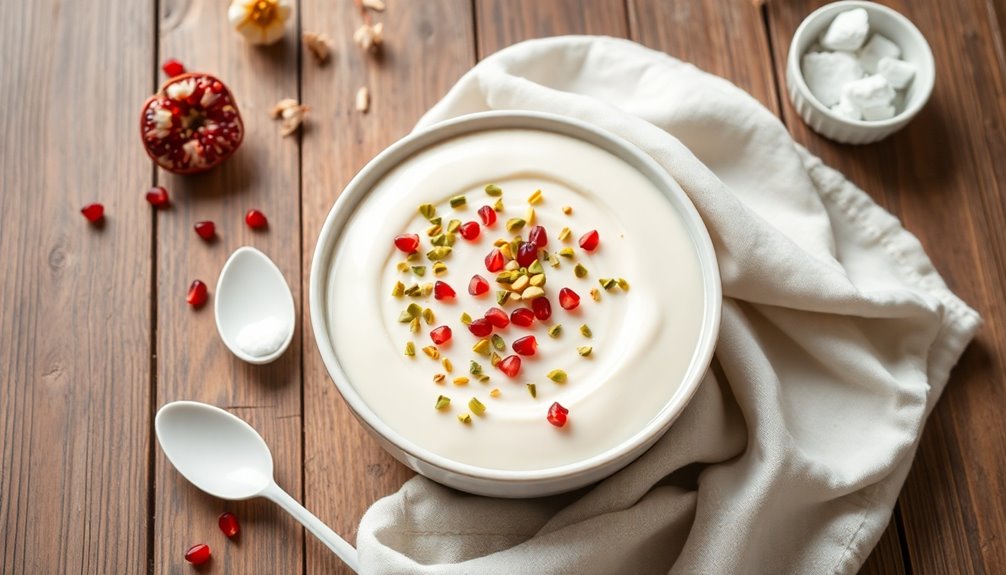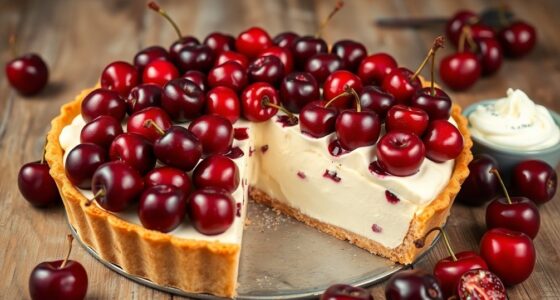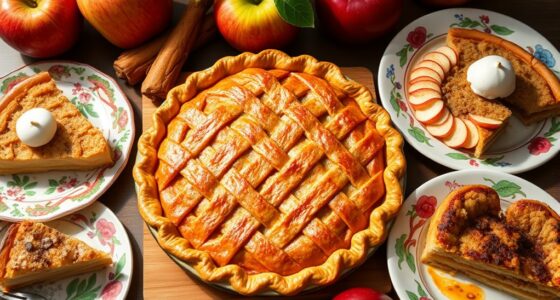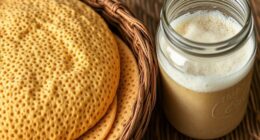Muhallebi is a delightful Middle Eastern pudding that's creamy and fragrant. It dates back to the 7th century and reflects a fusion of Persian and Arab culinary traditions. To make it, you combine milk, sugar, and cornstarch, then flavor it with rose water. It's often garnished with nuts or fruits and frequently enjoyed during special occasions. If you want to explore its rich history and variations further, there's so much more to uncover.
History

Muhallebi, also known as Mahalabia, has a rich history that dates back to the late seventh century when a Persian cook introduced it to Arab cuisine. Named after the Arab general Al-Muhallab ibn Abi Sufra, muhallebi quickly became a beloved Middle Eastern dessert. The earliest recorded recipes from the 10th century show various adaptations, indicating its evolving nature. During the Middle Ages, it transformed further, with Turkey's tavuk göğsü incorporating shredded chicken. The dish gained prominence in the Ottoman Empire, featuring in both royal banquets and daily meals. Borderline Personality Disorder has been noted for its emotional instability, which can be likened to the diverse adaptations of muhallebi throughout history.
Recipe
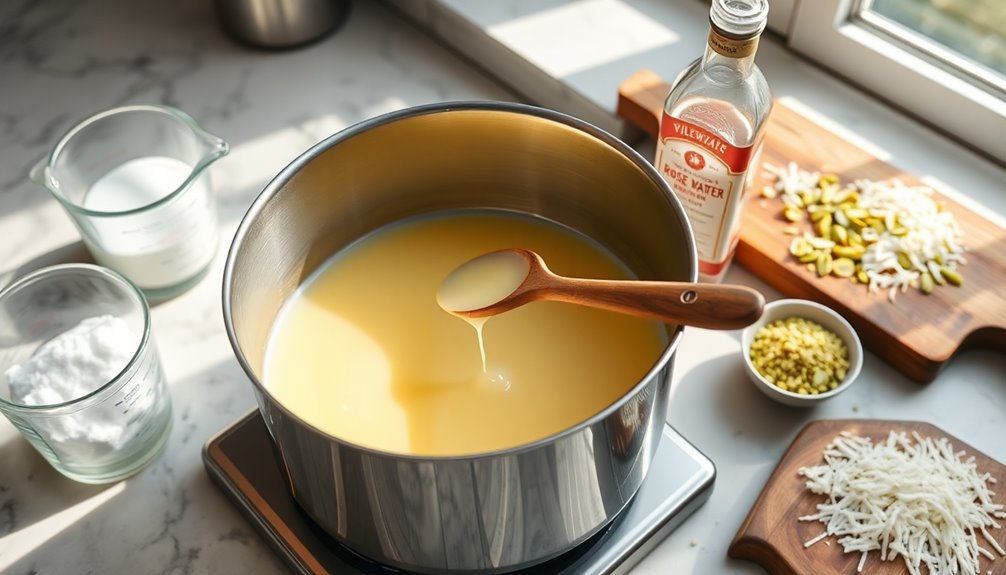
To prepare muhallebi, you'll need just a few basic ingredients, and the cooking process is quite straightforward. After cooking the pudding to the perfect consistency, it requires some chilling time to set, allowing the flavors to develop. Follow this easy recipe to create your own delicious muhallebi at home.
Ingredients:
- 4 cups whole milk
- 1 cup sugar
- 1/3 cup cornstarch (or rice flour)
- 1 tablespoon rose water (or other flavoring of choice)
- Garnishes: finely ground pistachios, shredded coconut, or seasonal fruits (pomegranate seeds, strawberries)
Cooking Instructions:
In a saucepan, combine the whole milk and sugar, and heat over medium heat until the sugar is fully dissolved.
In a separate bowl, mix the cornstarch with a small amount of cold milk to create a slurry, then add this mixture to the warm milk while stirring continuously.
Cook the mixture, stirring constantly, for about 10 minutes or until it thickens to a creamy consistency.
Once thickened, remove from heat and stir in the rose water or your chosen flavoring.
Pour the pudding into individual cups or a larger serving dish, then cover and refrigerate for at least four hours or preferably overnight to set.
Extra Tips:
When preparing muhallebi, make sure to stir the pudding continuously during cooking to prevent it from sticking to the bottom of the saucepan and ensure a smooth texture.
You can experiment with different flavorings according to your preference; vanilla and cardamom add a lovely aromatic touch.
For a more vibrant presentation, consider using a variety of garnishes to enhance both the flavor and appearance of the dish.
Lastly, serve the muhallebi chilled to enjoy its creamy texture fully! Additionally, you might enjoy pairing muhallebi with vegan cake pops for a delightful dessert experience.
Cooking Steps
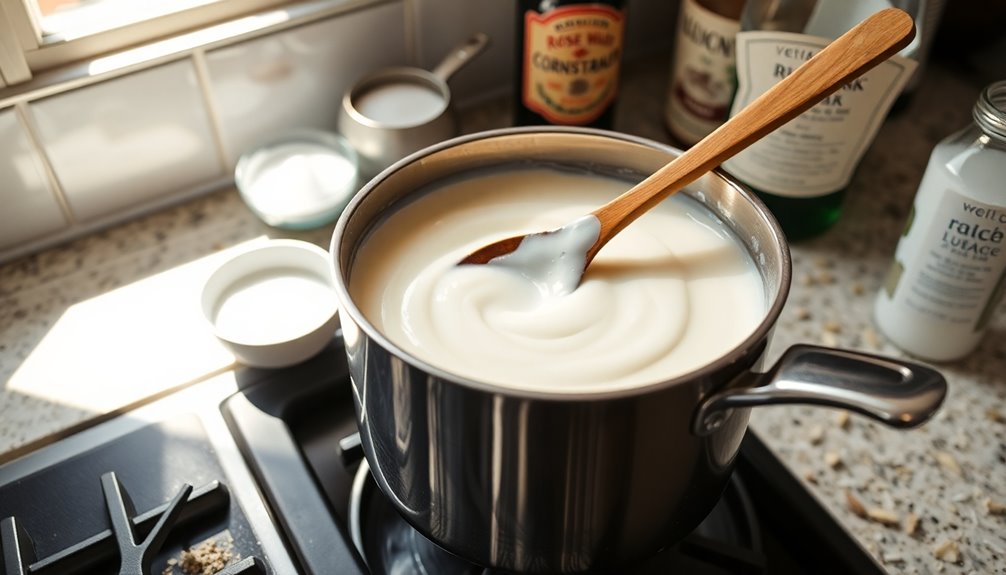
To get started on your muhalleb, gather all the ingredients you'll need.
First, mix the cornstarch with cold milk to create a smooth base before adding it to the heated milk and sugar.
With everything ready, you'll be on your way to a delicious dessert in no time! Additionally, consider adding chia seeds to your muhalleb for a nutritious boost and unique texture!
Step 1. Gather All Ingredients Needed

Gathering the right ingredients is essential for making a delicious Muhallebi. Start with 900 ml of whole milk, as it forms the base of this creamy dessert.
You'll also need 100 ml of cornstarch to achieve that perfect pudding-like consistency. Don't forget sugar for sweetness and rose water for a floral touch that elevates the flavor.
If you want a richer texture, consider adding heavy cream to your mixture.
You'll also want a medium-sized saucepan for cooking and a utility whisk for smooth mixing.
Finally, think about optional garnishes like chopped pistachios, shredded coconut, or a sprinkle of ground cinnamon to enhance both the presentation and taste of your finished Muhallebi. Additionally, using whole foods in your ingredients can improve the overall nutritional value of your dessert.
Happy cooking!
Step 2. Mix Cornstarch With Milk
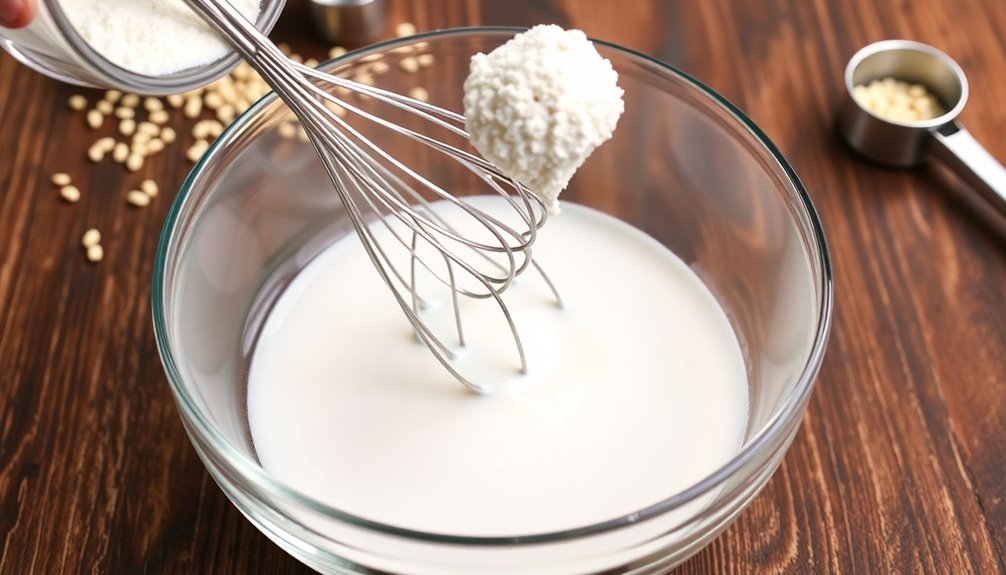
Now that you've gathered all the necessary ingredients, it's time to mix the cornstarch with milk.
Start by measuring 1 cup of cold whole milk. In a bowl, whisk in 2 ½ tablespoons of cornstarch until it's fully dissolved.
Make sure the cornstarch is well combined with the milk to prevent lumps later on when you add it to the heated mixture for your Mahalabia pudding. This step is crucial for achieving that desired thickened texture without clumping. Automation in butter production has also advanced the consistency and quality of creamy textures, similar to what you're aiming for in your pudding.
Once you've got a smooth mixture, set it aside while you prepare the remaining ingredients.
When the milk and sugar mixture is heated, you'll gradually pour in your cornstarch blend, stirring continuously until it thickens to a smooth consistency.
Step 3. Add Sugar and Flavoring

Start by combining 2 cups of whole milk and ½ cup of sugar in a medium saucepan over medium-high heat. Stir the mixture until the sugar fully dissolves.
Next, gradually whisk in the cornstarch that you've mixed with a small amount of cold milk, making sure to stir continuously to avoid lumps.
Once combined, reduce the heat to low and keep stirring until the mixture thickens to a smooth, pudding-like consistency, usually taking about 10 minutes.
After it thickens, remove the saucepan from the heat and stir in your chosen flavoring, like rose water or orange blossom water. This adds a delightful aroma and taste to your muhalleb.
Additionally, ensure you have a well-planned budget to manage your ingredients and cooking expenses effectively.
Now, you're ready to move on to the next step!
Step 4. Pour Into Serving Dishes

Once the Mahalabia mixture has thickened to a smooth pudding-like consistency, carefully pour it into individual glass dessert bowls or one large serving dish, making sure to distribute it evenly.
This step is crucial for achieving a delightful texture when you serve the pudding later. After pouring, let the Mahalabia cool at room temperature for about 10-15 minutes to avoid condensation.
Once slightly cooled, transfer it to the refrigerator. Aim to refrigerate the pudding for at least four hours, but overnight is even better for optimal setting. Moderation is key when serving desserts like Mahalabia, as excessive consumption can lead to health issues.
When you're ready to serve, consider garnishing the chilled Mahalabia with finely chopped pistachios and optional rose petals for an elegant touch that enhances its appeal.
Enjoy!
Step 5. Chill Until Set
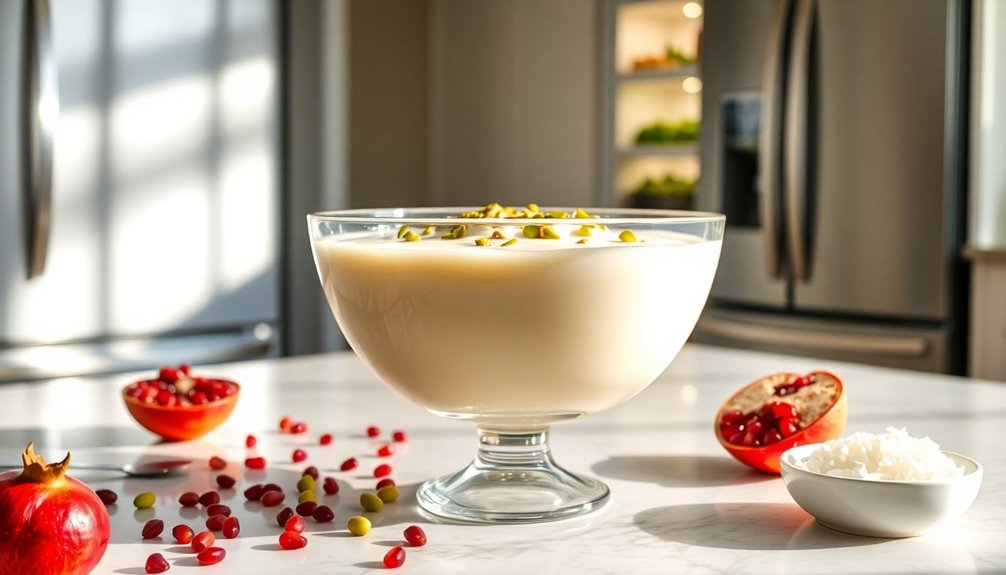
After you've poured the muhallebi mixture into your chosen dessert containers, it's essential to cover them with plastic wrap to prevent a skin from forming as it cools.
Now, it's time to chill the muhallebi in the refrigerator. Ideally, you should let it set for at least 4 hours or overnight for the best results.
As it chills, the pudding will firm up, making it easier to serve and enhancing the overall flavor. Additionally, you might consider pairing it with essential oils for relaxation, which can enhance the sensory experience while enjoying your dessert.
Once it's ready to serve, remove the plastic wrap and get creative with your garnish. You can top the muhallebi with nuts, fresh fruits, or a sprinkle of cinnamon.
This adds visual appeal and extra layers of flavor to your delightful dessert cups. Enjoy!
Final Thoughts
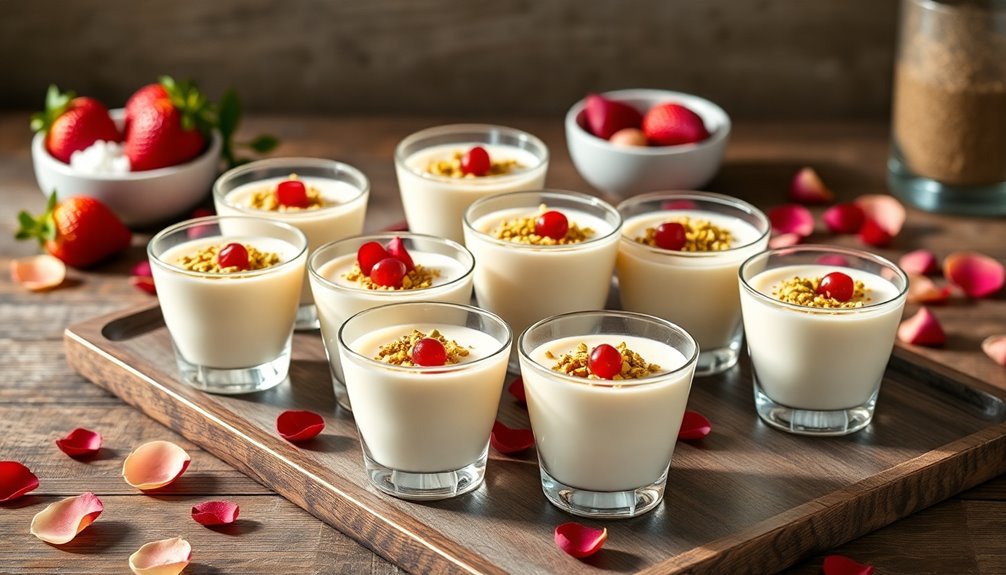
As you explore the delightful world of Muhallebi, it's clear that this traditional Middle Eastern pudding offers more than just a sweet treat; it embodies a rich cultural heritage and culinary history.
Dating back to the 7th century, Muhallebi reflects the flavors and traditions of Persian and Arab cuisines. Its creamy texture, enhanced by rose water, makes it a beloved dessert for any occasion, especially during Ramadan and weddings.
With variations across regions, from Turkish tavuk göğsü to Israeli malabi, you'll find something to suit every palate. Whether you savor it plain or topped with nuts, Muhallebi invites you to indulge in a timeless dessert that connects generations and celebrates the beauty of Middle Eastern flavors. Additionally, the preparation of Muhallebi often requires essential cooking equipment to achieve its perfect consistency.
Frequently Asked Questions
Where Is Muhallabia From?
When you explore the origins of certain dishes, you'll find that many have disputed roots, and this one's no exception.
It's believed to have ties to regions like Persia, Lebanon, Syria, and Egypt. Each culture has contributed to its evolution, making it a shared culinary treasure.
What Is the Origin of Mahalabiya?
Picture a warm kitchen, the air fragrant with spices, where culinary traditions blend over centuries.
The origin of Mahalabiya traces back to the late seventh century, introduced by a Persian cook in Arab cuisine. By the 10th century, it evolved, showcasing variations like the Turkish tavuk göğsü.
Throughout the Middle Ages, its popularity soared in Ottoman kitchens, with each region adding its own unique twist, creating a rich tapestry of flavors and cultural significance.
Where Does Mahalepi Come From?
Mahalepi comes from a rich culinary tradition that blends various cultural influences.
You'll find its roots trace back to Persian cuisine, which made its way into Arab cooking around the late seventh century.
Over time, it gained popularity throughout the Middle East, especially during the Middle Ages.
Its unique texture and flavor have captured hearts across regions, with each culture adding its own twist, making it a beloved dessert today.
What Is Malabi in English?
Malabi, in English, is often referred to as "milk pudding."
It's a creamy dessert made primarily from milk, sugar, and a thickening agent like cornstarch. You might find it flavored with ingredients like rose water or vanilla, adding a fragrant twist.
When you enjoy malabi, it's usually topped with nuts, coconut, or fruits, making it not just delicious but visually appealing too.
It's a sweet treat that many love during special occasions.
Conclusion
In the end, making muhallebi is like crafting a delicate piece of art; each layer adds depth and flavor to your creation. Just like how a painter chooses their colors, you select the ingredients that bring your dish to life. Imagine sharing this creamy delight with friends, each spoonful sparking joy and nostalgia. So, go ahead and whip up some muhallebi—it's not just a dessert, it's a sweet moment waiting to happen. Enjoy every bite!
